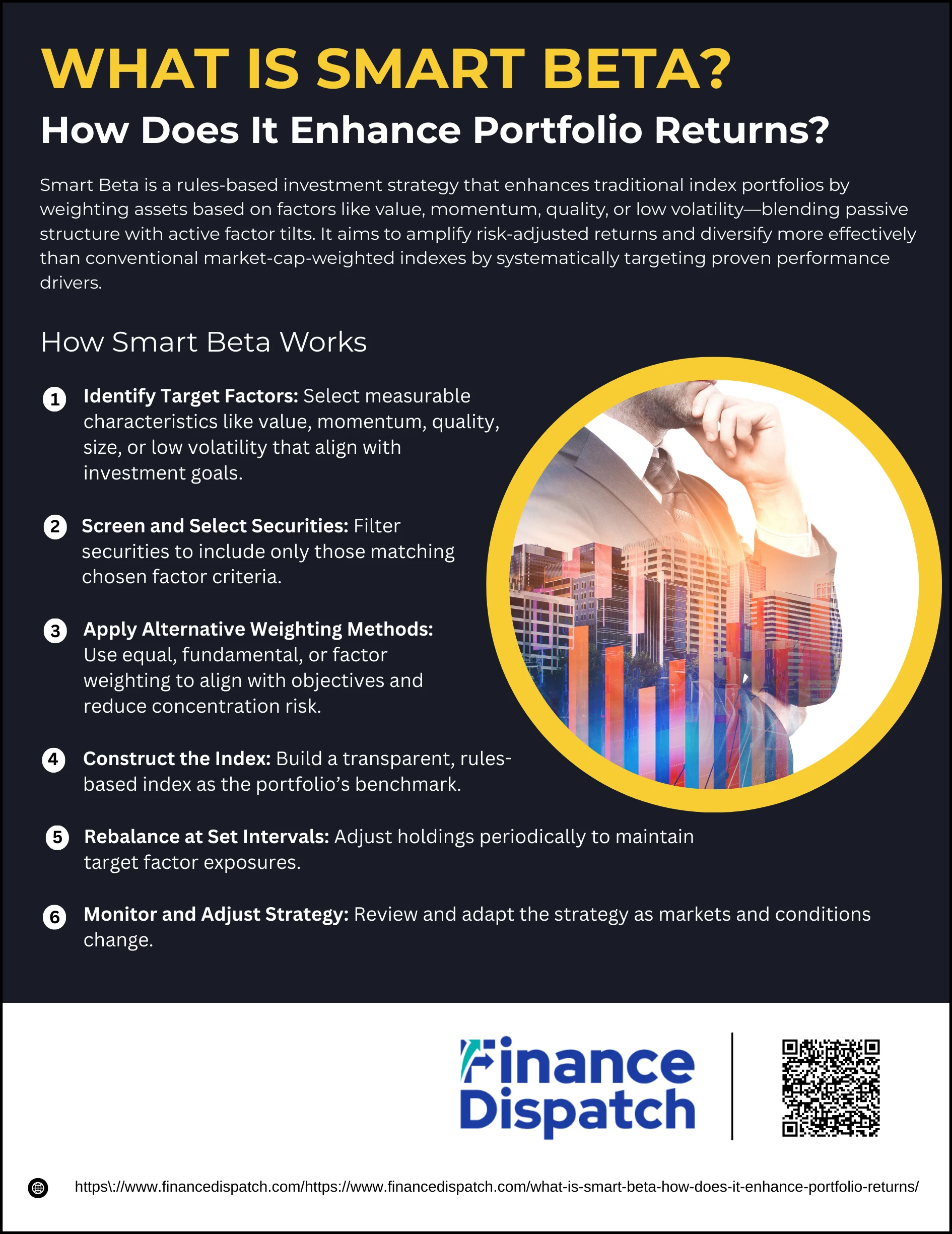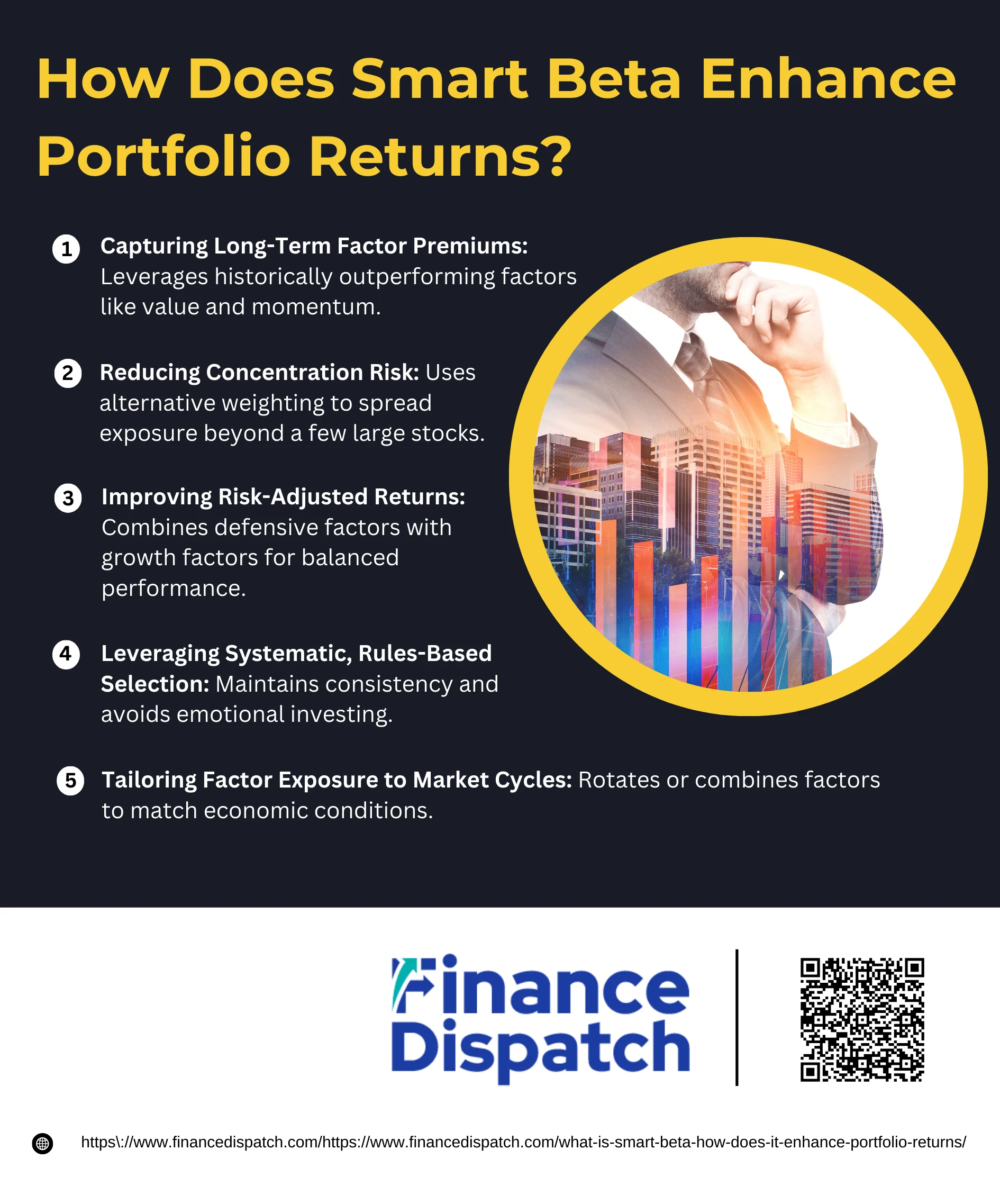In today’s investment landscape, many investors are searching for a strategy that blends the low costs and transparency of passive investing with the targeted performance potential of active management. This is where Smart Beta comes in. Positioned between these two approaches, Smart Beta uses rules-based, factor-driven methods to build portfolios that aim to outperform traditional market-capitalization indices. By focusing on proven factors such as value, momentum, quality, size, and low volatility, Smart Beta strategies seek not only to capture market returns but also to enhance them. The result is a flexible, data-informed approach that can improve diversification, manage risk more effectively, and unlock additional sources of return — all while maintaining a systematic and transparent framework.
 What is Smart Beta?
What is Smart Beta?
Smart Beta is an investment approach that combines the efficiency of passive index tracking with the targeted strategies of active investing. Instead of weighting securities purely by market capitalization, Smart Beta uses alternative, rules-based methodologies to select, weight, and rebalance a portfolio based on specific factors that have historically influenced returns. These factors — such as value, momentum, quality, size, and low volatility — are chosen to exploit market inefficiencies and capture long-term performance premiums. By systematically tilting portfolios toward these characteristics, Smart Beta aims to improve risk-adjusted returns, reduce concentration risk, and provide a more tailored investment solution compared to traditional index funds.
How Smart Beta Works
Smart Beta works by combining the low-cost, transparent nature of passive investing with the performance-focused design of factor investing. Instead of tracking a traditional market-capitalization-weighted index, Smart Beta follows a customised, rules-based index designed to capture specific factors that historically influence investment returns. This systematic approach helps investors achieve objectives like higher returns, lower risk, or improved diversification, all while avoiding emotional decision-making and maintaining portfolio discipline.
1. Identify Target Factors
The foundation of any Smart Beta strategy is deciding which investment factors to target. Factors are measurable characteristics of securities that can explain differences in returns and risk over time. Common factors include:
- Value (buying undervalued stocks based on ratios like price-to-earnings or price-to-book)
- Momentum (focusing on stocks with strong recent performance)
- Low Volatility (selecting stocks with stable price movements)
- Quality (investing in financially healthy companies with strong earnings and low debt)
- Size (targeting small-cap or large-cap companies depending on growth or stability objectives)
Choosing the right mix of factors depends on an investor’s goals, market outlook, and risk tolerance.
2. Screen and Select Securities
Once the factors are chosen, securities are filtered through a rules-based screening process. For example, a value-focused Smart Beta strategy might only include stocks with low price-to-book ratios, while a quality-focused strategy might require stable earnings growth and low leverage. This step ensures that only securities matching the chosen factor characteristics make it into the portfolio.
3. Apply Alternative Weighting Methods
Unlike market-cap weighting, where larger companies dominate the index, Smart Beta uses alternative weighting techniques to better align with investment goals. Examples include:
- Equal Weighting – each security gets the same portfolio allocation, improving diversification.
- Fundamental Weighting – weighting based on earnings, dividends, or book value.
- Factor Weighting – assigning more weight to securities that score highly on the targeted factors.
These methods help reduce concentration risk and improve exposure to the intended factors.
4. Construct the Index
After selecting securities and assigning weights, a custom index is created. This index becomes the benchmark that the Smart Beta portfolio will follow. The construction is fully transparent, with clear rules that dictate which securities are included, how they are weighted, and when adjustments will be made.
5. Rebalance at Set Intervals
Over time, market movements can cause factor exposure to drift from the original strategy. To keep the portfolio aligned with its objectives, it is rebalanced periodically — often quarterly, semi-annually, or annually. For example, if a low-volatility stock becomes more volatile, it may be replaced with one that fits the strategy’s criteria better.
6. Monitor and Adjust Strategy
While Smart Beta strategies are rules-based, they still require monitoring to ensure they remain effective in changing market conditions. Performance reviews may lead to adjustments, such as incorporating new factors, changing weighting methods, or updating the rebalancing schedule. This ongoing oversight helps maintain the strategy’s relevance and effectiveness over the long term.
The Key Factors Driving Smart Beta Strategies
Smart Beta strategies are built around “factors” — specific, measurable traits of securities that have historically been linked to differences in performance and risk. These factors allow investors to move beyond traditional market-cap-weighted approaches and instead tilt their portfolios toward characteristics that align with their investment goals. By systematically targeting these factors, Smart Beta strategies can improve diversification, reduce risk exposure, and potentially enhance returns over time. Each factor plays a distinct role, and understanding them helps investors choose the right strategy for their objectives.
1. Value
The value factor focuses on stocks that are priced low relative to their fundamental metrics, such as earnings, dividends, or book value. This approach assumes that undervalued companies have the potential for price appreciation as the market corrects its mispricing. For example, a value-focused Smart Beta ETF might prioritise companies with low price-to-earnings (P/E) ratios and high dividend yields, aiming to benefit when their prices rise to match their intrinsic worth.
2. Momentum
Momentum strategies look for stocks with strong recent performance, under the premise that trends often persist for a certain period. This factor can capture the psychological and behavioral biases of the market, where investors continue buying winning stocks. A momentum Smart Beta fund might give higher weights to companies whose share prices have risen significantly over the past 6–12 months, expecting the trend to continue.
3. Low Volatility
This factor targets stocks with smaller price fluctuations compared to the market average. By holding assets that tend to remain stable, low-volatility strategies aim to reduce portfolio risk while still participating in market gains. For instance, a low-volatility Smart Beta ETF might focus on consumer staples or utilities companies, which generally experience fewer sharp price movements during economic downturns.
4. Quality
Quality investing emphasises financially robust companies with healthy balance sheets, consistent earnings growth, and strong return on equity. Quality stocks tend to be more resilient in downturns and offer steady performance in the long term. A quality Smart Beta portfolio might exclude highly leveraged companies and instead favour firms with stable cash flows and strong profit margins.
5. Size
The size factor adjusts exposure based on a company’s market capitalization. Small-cap stocks can offer higher growth potential but tend to be more volatile, while large-cap stocks often provide stability and dividend income. A Smart Beta strategy might overweight small-cap stocks for growth-focused investors or large-cap stocks for those seeking stability.
 How Does Smart Beta Enhance Portfolio Returns?
How Does Smart Beta Enhance Portfolio Returns?
Smart Beta enhances portfolio returns by combining the consistency of passive investing with the performance-driven focus of active strategies. Instead of tracking traditional market-cap-weighted indices, Smart Beta strategies systematically tilt portfolios toward specific factors — such as value, momentum, quality, size, or low volatility — that have historically delivered superior risk-adjusted performance. By doing so, they aim to capture additional return opportunities, reduce concentration risk, and improve portfolio resilience across different market environments.
1. Capturing Long-Term Factor Premiums
Smart Beta targets well-researched investment factors that have historically outperformed the broader market over long periods. For example, value and momentum factors have shown the potential to deliver excess returns when applied systematically.
2. Reducing Concentration Risk
Traditional market-cap indices can become dominated by a few large companies. Smart Beta uses alternative weighting methods, such as equal or fundamental weighting, to spread exposure more evenly and avoid over-reliance on a small set of stocks.
3. Improving Risk-Adjusted Returns
By incorporating factors like low volatility and quality, Smart Beta strategies can help reduce portfolio risk while maintaining or enhancing returns. This leads to better performance per unit of risk taken.
4. Leveraging Systematic, Rules-Based Selection
Smart Beta eliminates emotional decision-making by following transparent, rules-based methodologies. This consistency helps capture performance opportunities while avoiding common behavioural pitfalls.
5. Tailoring Factor Exposure to Market Cycles
Different factors tend to perform better in different economic environments. By combining or rotating between factors, Smart Beta strategies can adapt to changing market conditions and smooth out long-term performance.
Why Investors Choose Smart Beta
Investors are increasingly turning to Smart Beta as a way to bridge the gap between the low costs of passive investing and the targeted performance potential of active strategies. By systematically tilting portfolios toward specific investment factors, Smart Beta offers a disciplined, transparent approach that can be customised to meet different financial objectives. This flexibility, combined with its focus on enhancing returns and managing risk, makes it a compelling choice for many market participants.
1. Improved Diversification: Reduces overexposure to a handful of large-cap stocks by spreading allocation across a wider range of securities or factors.
2. Potential for Outperformance: Targets proven factors like value or momentum that have historically delivered excess returns over the market.
3. Better Risk Management: Incorporates defensive factors such as low volatility or quality to help cushion portfolios during market downturns.
4. Lower Costs Than Active Funds: Maintains cost efficiency by using a rules-based approach, avoiding the high fees of fully active management.
5. Customisation Flexibility: Allows investors to design portfolios aligned with their specific goals, whether they seek growth, income, or stability.
Potential Challenges and Limitations of Smart Beta
While Smart Beta offers a compelling blend of passive efficiency and factor-based precision, it is not without its drawbacks. Investors need to be aware that targeting specific factors can lead to periods of underperformance, higher costs compared to traditional indexing, and increased complexity in understanding how these strategies work. Recognizing these challenges is essential to setting realistic expectations and making informed investment decisions.
1. Higher Costs Than Traditional Index Funds – Smart Beta strategies often have higher expense ratios than simple market-cap-weighted funds due to their customised index construction and more frequent rebalancing.
2. Factor Cyclicality – No factor consistently outperforms in all market conditions, meaning strategies may underperform when their targeted factor is out of favour.
3. Complexity for Retail Investors – Understanding factor definitions, weighting methods, and portfolio construction rules can be challenging for those new to the concept.
4. Overreliance on Historical Data – Many Smart Beta strategies are designed using back-tested results, which may not reflect future performance in changing market environments.
5. Limited Availability of Certain Strategies – Some factor-based approaches may not be widely available across all asset classes, regions, or fund providers.
Real-World Examples of Smart Beta Funds
Smart Beta strategies are widely implemented through exchange-traded funds (ETFs) and mutual funds that track custom-built, factor-focused indices. Each fund applies a specific methodology to tilt the portfolio toward chosen characteristics such as value, momentum, quality, or dividend growth. These examples illustrate how different Smart Beta funds operate, highlighting their objectives, factor focus, and market presence.
1. Vanguard Value Index Fund ETF Shares (VTV) – Tracks the CRSP US Large Cap Value Index, focusing on undervalued large-cap U.S. stocks using metrics like price-to-book, forward price-to-earnings, and price-to-sales ratios. Assets under management (AUM): $132.1 billion (Jan 2025).
2. iShares Russell 1000 Growth ETF (IWF) – Seeks growth-oriented large-cap U.S. stocks based on factors like price-to-book, medium-term growth forecasts, and sales-per-share growth. AUM: $105 billion (Jan 2025).
3. Vanguard Dividend Appreciation Index Fund ETF Shares (VIG) – Targets companies with at least 10 consecutive years of increasing dividend payments, weighted by market capitalization. AUM: $87.8 billion (Jan 2025).
4. iShares MSCI USA Momentum Factor ETF (MTUM) – Focuses on high-momentum U.S. equities, weighting stocks by recent performance trends to capture short- to medium-term price momentum.
5. Invesco S&P 500 Equal Weight ETF (RSP) – Applies equal weighting to all S&P 500 constituents, reducing concentration risk in the largest companies.
6. iShares Edge MSCI USA Quality Factor ETF (QUAL) – Invests in financially strong U.S. companies with stable earnings, low debt, and high profitability.
7. Vanguard High Dividend Yield ETF (VYM) – Concentrates on high-dividend-paying U.S. stocks, appealing to income-focused investors.
 Steps to Start Investing in Smart Beta
Steps to Start Investing in Smart Beta
Smart Beta investing offers a structured, factor-driven way to potentially enhance returns and manage risk, but its success depends on making informed choices at every stage. This means understanding your investment goals, selecting the right combination of factors, and choosing funds that are transparent, cost-efficient, and aligned with your portfolio strategy. Following a clear process can help you avoid costly mistakes and ensure Smart Beta plays a productive role in your long-term financial plan.
1. Define Your Investment Objectives
Begin by clearly stating what you want to achieve with your investments. Are you aiming for higher growth, reduced volatility, steady income, or broader diversification? For example:
- Growth-focused investors might lean toward momentum or small-cap factors to capture upside potential.
- Risk-averse investors may prefer low-volatility or quality factors to minimise drawdowns.
- Income-seekers could focus on dividend growth or high-dividend yield strategies.
Understanding your goals helps narrow down which Smart Beta approach fits best.
2. Research Available Smart Beta Funds
Explore the range of ETFs and mutual funds that use Smart Beta methodologies. Compare:
- Factor focus (value, momentum, low volatility, etc.)
- Performance history under various market conditions
- Expense ratios and fees
- Provider reputation
The aim is to find funds that have consistently delivered results aligned with their stated strategy.
3. Understand the Weighting Methodology
The way a Smart Beta fund allocates weights can significantly affect its risk and return profile:
- Equal weighting improves diversification by giving each security the same importance.
- Fundamental weighting uses metrics like earnings or book value to determine weight.
- Factor-based weighting prioritizes securities that strongly exhibit the targeted factor.
Knowing this helps you anticipate how the fund may behave in different markets.
4. Diversify Across Factors and Regions
Relying on one factor can expose you to periods of underperformance. Combining factors — for example, blending value and momentum — can smooth returns. Similarly, diversifying geographically across U.S., European, and emerging market Smart Beta funds can reduce region-specific risks.
5. Select the Right Funds
Choose funds that balance your target factors, desired risk level, and cost considerations. Also, ensure they have sufficient assets under management (AUM) and trading volume to provide liquidity. Avoid niche Smart Beta funds with very low AUM unless you have high conviction in the strategy.
6. Integrate and Monitor Your Portfolio
Incorporate Smart Beta funds alongside your other holdings, ensuring they complement your overall asset allocation. Review performance regularly and rebalance to maintain your intended factor exposures. For example, if a momentum fund’s strong returns cause it to become overweight, trimming it back can help keep your portfolio balanced.
7. Keep an Eye on Costs and Liquidity
While Smart Beta is generally more affordable than active management, it still costs more than traditional indexing. Over time, even small fee differences can impact returns. Check bid-ask spreads to ensure you can trade efficiently, and avoid funds with poor liquidity that may be costly to exit in volatile markets.
The Future of Smart Beta
The future of Smart Beta is poised to be shaped by innovation, technology, and evolving investor preferences. As markets become increasingly data-driven, advancements in artificial intelligence and machine learning are enabling more dynamic factor selection and portfolio adjustments, allowing strategies to adapt in real time to changing market conditions. The growing emphasis on sustainability is also leading to greater integration of Environmental, Social, and Governance (ESG) criteria into Smart Beta methodologies, aligning performance objectives with responsible investing goals. Additionally, Smart Beta is expected to expand its reach beyond equities, with greater adoption in fixed income, commodities, and multi-asset portfolios. Concepts like “Smart Alpha,” which blend systematic factor exposure with selective active management, may also gain traction, offering even more customisation for investors. As accessibility improves through ETFs and digital platforms, Smart Beta is likely to remain a key tool for those seeking a balance between cost efficiency, targeted returns, and portfolio resilience.
Conclusion
Smart Beta has emerged as a powerful middle ground between traditional passive indexing and active management, offering investors a rules-based, transparent approach to targeting proven performance factors. By tilting portfolios toward characteristics such as value, momentum, quality, size, or low volatility, it aims to enhance returns, improve diversification, and better manage risk compared to conventional market-cap-weighted strategies. However, while the potential benefits are compelling, investors must also be mindful of its challenges — including higher costs than basic indexing, factor cyclicality, and the need for a deeper understanding of how each strategy works. When carefully selected and integrated into a well-balanced portfolio, Smart Beta can serve as a valuable tool for achieving specific investment objectives while maintaining discipline and cost efficiency in an ever-changing market landscape.



